If you’re looking for complementary and alternative medicine to address your headache, then we’ve got some great natural remedies for you along with the research to back ’em up.
And if you’ve had some experience with one of the treatment options, share your experience on our Facebook page.
Energy Medicine | Hypnotherapy | Meditation | Acupuncture | Acupuressure | Reflexology | Chiropractic | Massage Therapy | TuiNa | Thai Massage | Shiatsu | Myofascial Release
Energy Medicine
There’s a long list of energy medicine practices including healing touch, quantum healing, therapeutic touch, and Reiki that may be effective for headaches. Other energy healing practices, such as Shakti Swarupa or the Emotion Code, offer the hope of improved health where sometimes no hope exists.
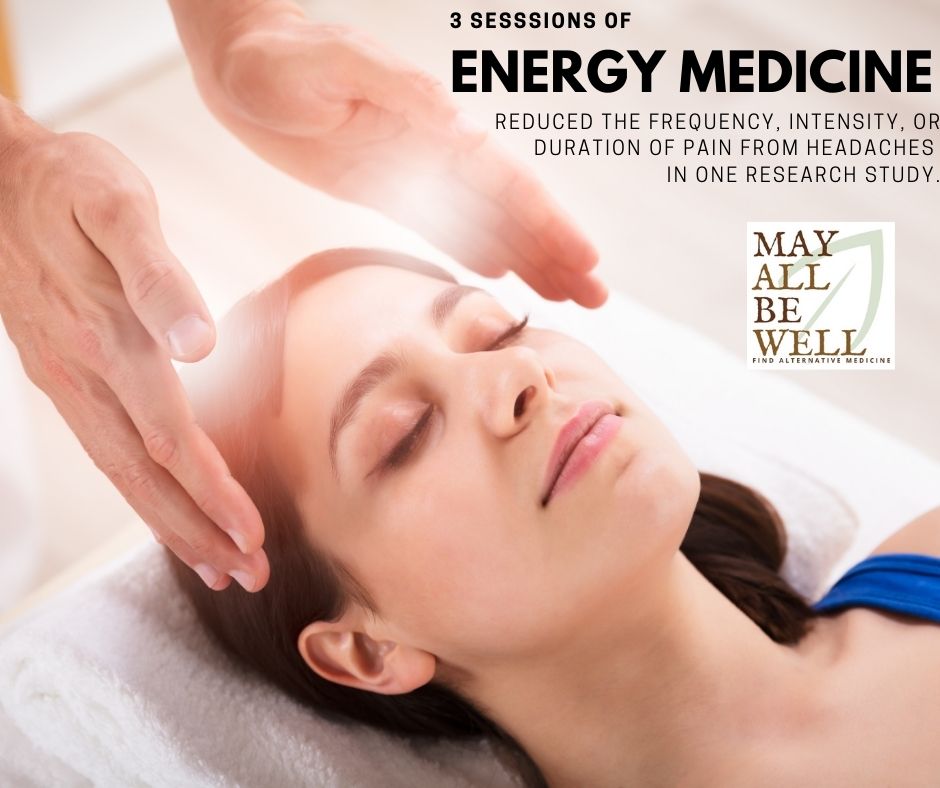
In fact, one study on Energy Medicine for Chronic Headaches published in the Journal of Alternative and Complementary Medicine, found that participants experienced profound shifts in their view of themselves, their lives, and their potential for healing and transformation.
Whether you believe in the research studies that promote the beneficial effects of energy medicine, like reducing the frequency, intensity, or duration of pain from headaches, or if you think energy medicine is a pseudoscience that shouldn’t be taken seriously, when conventional treatments fail, some people are willing to take the risk and step into the unknown to experience the spiritual and transcendent power of energy healing.
Will you? Or maybe you just want to close your eyes and…
Quack Like a Duck?
Nah…that’s just a joke stage hypnotists use to get some laughs and nothing like what you experience with clinical hypnotherapy. Let’s be real, when the U.S. Department of Veteran Affairs recommends a treatment option for headaches, then you know it’s not quackery (get it, quack–ery…?), and the VA lists hypnosis as a viable treatment option for headaches.
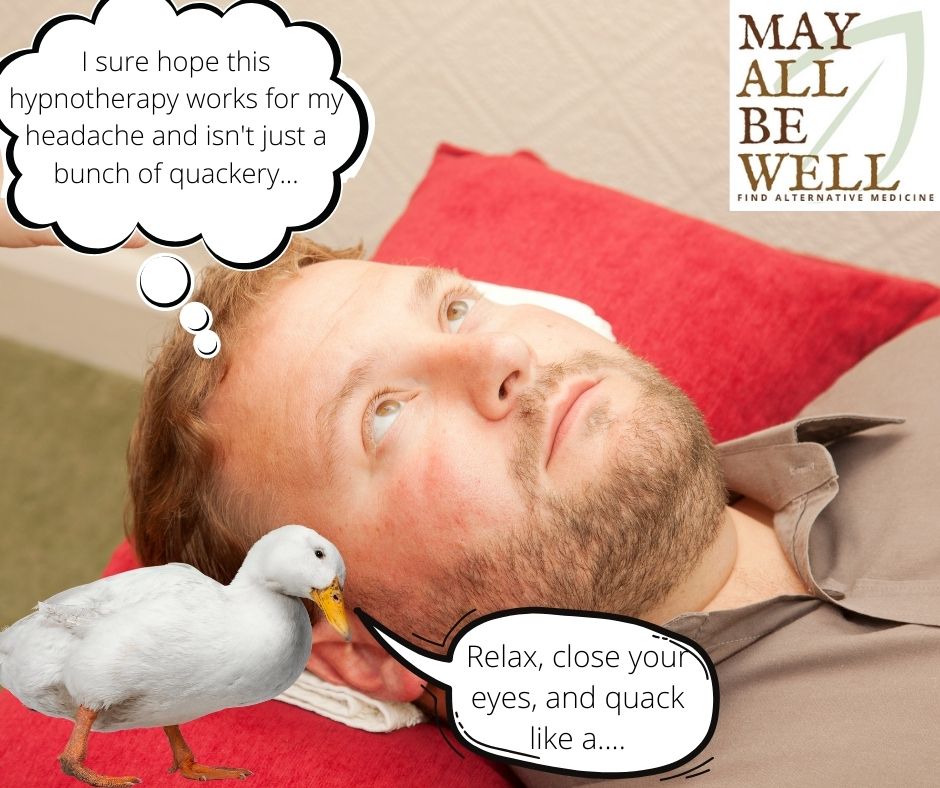
That’s because this systematic review looked at eight research studies showing that “hypnotherapy and relaxation techniques are effective in reducing short- and long-term headache activity in migraine sufferers.”
Now that’s something to *quack* about!
If you suffer from tension headaches, hypnotherapy could make your headache seem like water off a duck’s back. You’ll be relaxed, headache-free, and ready to conquer the next thing on your to-do list, even if that’s a nap! Cause ya know, you can’t take a nap when you’re head is throbbin’…
This study on the use of hypnotherapy for tension headaches demonstrated that participants using hypnosis showed “significant reductions in the number of headache days, the number of headache hours and headache intensity.”
Learn more about hypnotherapy for headaches and migraines. Then get your ducks in a row, and try some hypnotherapy so you’ll be as happy as a duck! Or maybe you just want to…
Close Your Eyes and Breath
All those people meditating look so peaceful and relaxed, so it shouldn’t be surprising that meditation has gained a lot of attention as a preventative measure as well as a remedy for headaches.
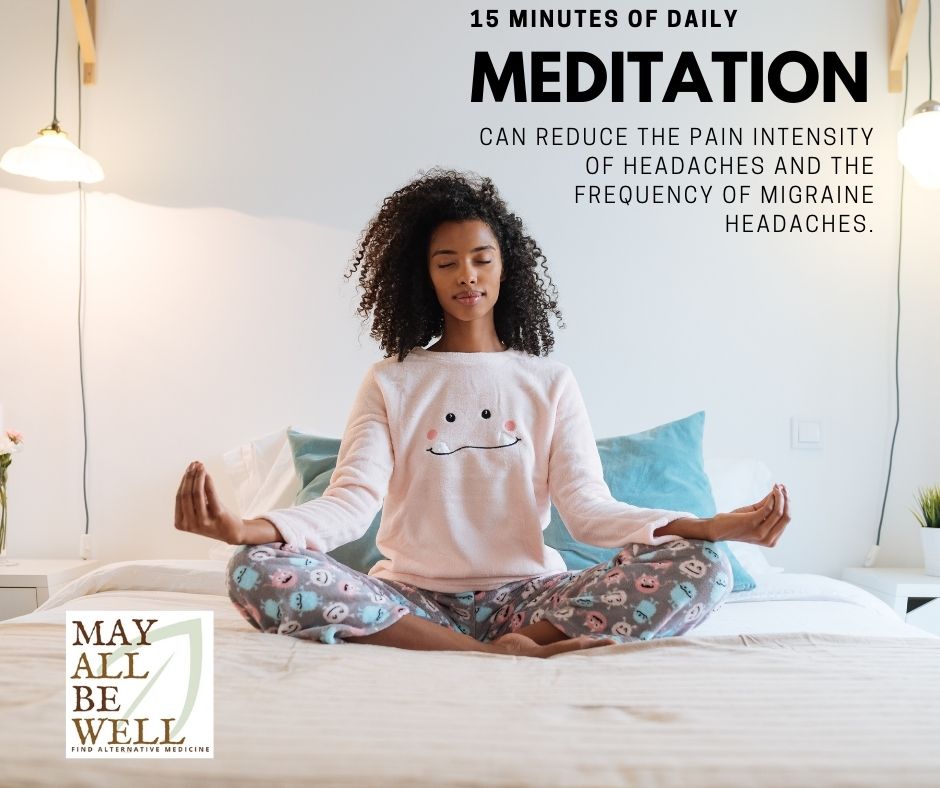
That’s because a meta-analysis of eleven research studies found that meditation reduces the pain intensity of headaches. While other studies on the use of meditation for migraines found a decrease in the frequency of migraine headaches and a reduction in the amount of medication used for migraine headaches.
Meditation is easy to learn and costs practically nothing once you’ve learned how. The challenge is investing the time and effort into actually doing it.
Studies demonstrating positive effects of meditation on headaches had meditators practicing for as little as 15 minutes and as long as up to 2 hours and daily in most cases. So it sounds like you’re trading time for the convenience of taking medication to relieve your pain. But unlike medication, meditation has no associated side-effects.
Stick a Needle in It!
Acupuncture has long been used in the treatment of headaches and is recognized for treating the pain associated with tension headaches and migraine headaches.
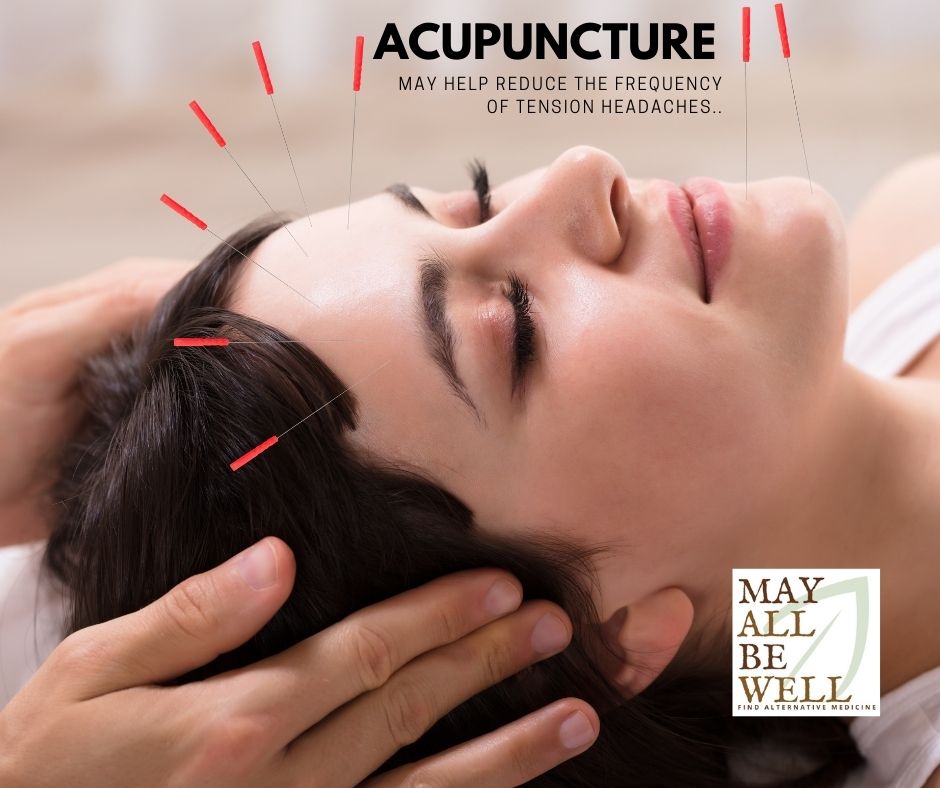
Research studies also suggest acupuncture may help reduce the frequency of tension headaches and prevent migraine headaches. In a meta-analysis published by Vickers et al reported that “acupuncture leads to persisting, clinically relevant benefits for primary care patients with chronic headache, particularly migraine.”
It’s the persisting part that has us intrigued. Some headache remedies may mask the symptoms of the headache for a period of time, but this research suggests that the effects of acupuncture for headaches and migraines persist after the treatments, which is great news for chronic sufferers!
Jean Carr is an acupuncturist in Tucson who specializes in Japanese Acupuncture. She shares, “A good acupuncturist considers changes to your mood, your sleep, your digestion, anything. So I’m looking holistically, even when I treat a particular symptom like headaches.”
She shares that the effectiveness of using acupuncture for headache pain depends on your age and how long you’ve experienced the headaches. Depending on those factors, it may take more or less time for you to experience the results you’re seeking.
“Some people will tell me their mood is better, their sleep is better, their spouse and children think they’re nicer, but their head still hurts,” states Carr, “So I like to encourage people to see the entire picture…that I just can’t heal your headache, I heal the whole system, and it may take a while for your headache pain to go away.”
If your aversion to needles isn’t too great, consider sticking a needle in it to help your headache go away.
Learn more about acupuncture for headaches and migraines.
Put Some Pressure On It
Acupressure is a traditional Chinese bodywork technique that involves the use of physical pressure on different pressure points on the surface of the body, to help the free flow of energy in the channels. Some research studies also suggest that acupressure can be used to help relieve headaches and to lessen the number of headaches that occur.
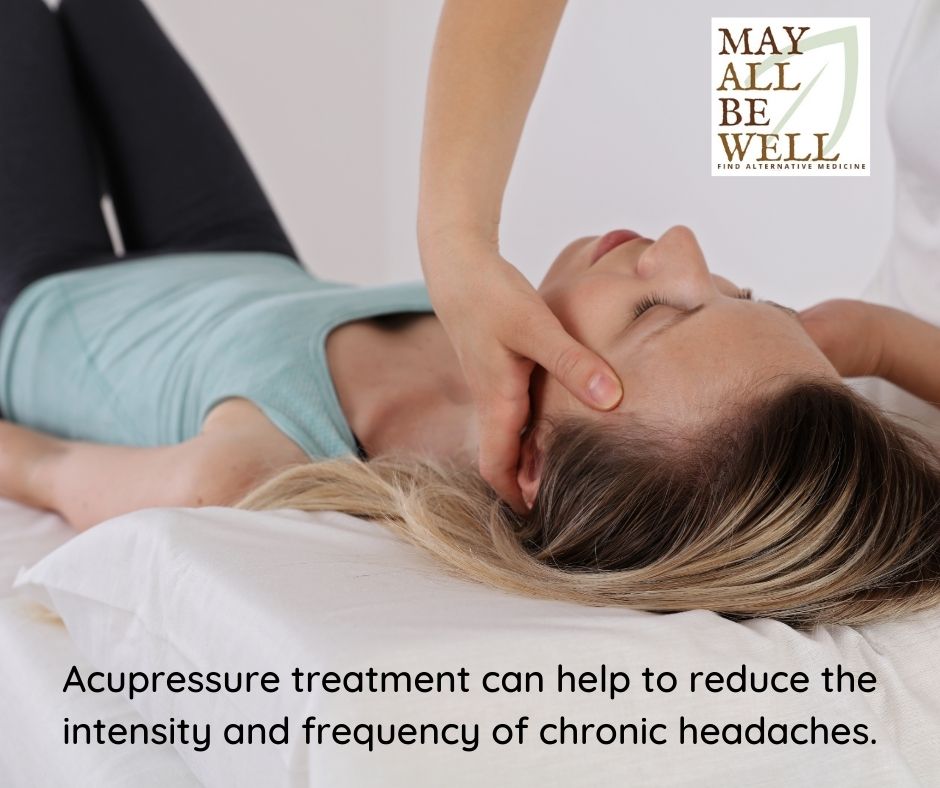
The physical pressure can be placed by the hand, elbow, or the aid of a device on the patients’ body. Acupressure is known to bring relief through the balance of energies and the circulation of fluids.
In a systematic review that was conducted to study the effectiveness of acupressure on relieving pain, it was shown that acupressure was effective at providing pain relief within different types of populations, including chronic headaches.
In a clinical study conducted on the effect of acupressure and trigger points in treating headaches, twenty-eight patients who suffered from chronic headaches were placed into two different groups, the acupressure group or the muscle relaxant group.
After one month of treatment and a six-month follow-up, it was proven that acupressure was more successful at reducing chronic headaches than the muscle relaxant was.
Thumb Walking
Now, we know what you’re thinking…
What is thumb walking and how’s it gonna help my headache?
Well, don’t bail on us yet…
Thumb walking is a technique used in reflexology and in a clinical study that was conducted to test reflexology treatment for headaches, 220 patients with migraines or tension headaches were studied and treated with reflexology.

During the three-month follow-up, it was shown that 81% of patients were helped or cured of their headaches by the reflexology, and 19% were able to stop their headache medications!
Reflexology is an alternative medicinal practice that involves applying different amounts of pressure to the hands, feet, and ears. It shows how one part of the body relates to another part of the body.
It is based on the thought that the hands, feet, and ears are connected to certain organs and types of body systems, which can provide health benefits if massage-like pressure is applied to those areas of the body.
During a systematic review about the concept and evidence of reflexology, it was shown that reflexology is effective for general well-being maintenance and treatment of chronic diseases, including headaches.
It includes a soothing massage and is not complemented by drugs, so negative side effects are minimal. Even though it is proven positive on small-scale trials, larger-scale ones are still needed.
Reflexology is easy to learn and something you can do for yourself. So now, the moment we’ve all been waiting for…how to thumb walking:
Your Complete Guide to Thumb Walking
We Got Your Back…
Chiropractic is a field of study that diagnoses and treats disorders of the musculoskeletal system. Chiropractic therapy is a form of alternative medicine where the hands or a small instrument are used to manipulate the spine or other parts of the body. This kind of treatment emphasizes the ability of the body to heal itself.
Chiropractic treatment can provide relief of pain caused by chronic headaches and migraines with this non-invasive, non-addictive, and safe method of care provided by a chiropractor. It helps you to increase the mobility of your joints and fix misalignments in your spine.
In a study conducted on chiropractic spinal manipulative treatment (CSMT) for migraine headaches, a 52 year old woman who has suffered chronic migraines for a long period of time was provided CSMT.
The chiropractic treatment was proven effective in her case, as she did not experience any chronic migraines at her six-month follow-up, when she used to have at least one each month prior to the treatment.
During a case study about integrating chiropractic care into the treatment of migraine headaches, it was shown that chiropractic treatment on patients experiencing migraines was helpful in releasing pain and frequency.
Many people that experience chronic headaches and migraines have neck pain associated with them. The use of chiropractic treatment to ease this pain and lessen the amount of migraines that they experience.
Headaches? Knot a Problem
Massage therapy can work your knots out, and it’s been around for thousands of years to treat a variety of different problems, relax the body, and to promote overall well-being.
So it should come as a surprise that massage therapy can also be used to lessen the amount of pain experienced by chronic headaches and migraines and to help reduce the frequency with which they occur.
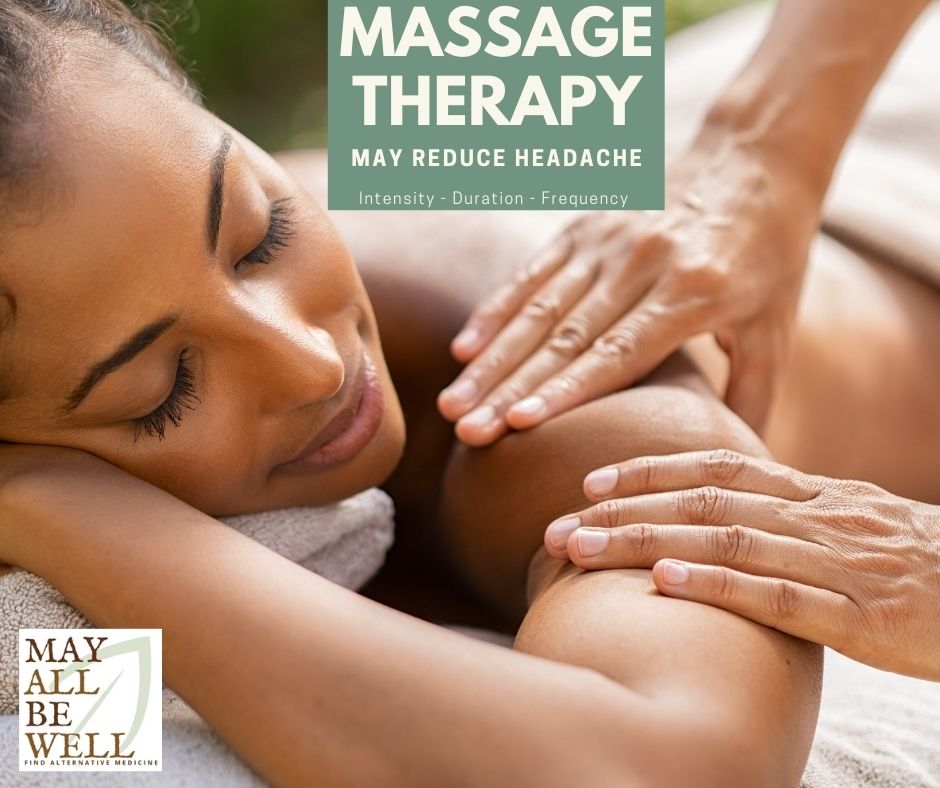
When treating headaches, massages are typically focused on the shoulders, neck, and head to decrease discomfort and pain experienced by the individual. Doing this type of massage therapy can help to ease pressure and tension related to headaches and migraines.
In a study about massage therapy and frequency of chronic tension headaches, patients that struggled with chronic tension headaches received massage therapy, mainly focused on the neck and shoulder muscles.
The result of this study was that massage therapy reduced the frequency of the headaches significantly, as well as the duration of the headaches.
It was shown that massage therapy was a functional and effective way to reduce the pain associated with chronic headaches, as well as the frequency of the headaches.
In a study involving changes in clinical parameters in patients with tension-type headaches after massage therapy, short term changes were monitored by headache patients experiencing massage therapy.
It was concluded that massage therapy reduced the intensity, duration, and frequency of the headaches throughout the study. These reductions also lasted at least three weeks following the massage therapy.
TuiNa
Tuina is an ancient Chinese form of alternative medicine that is thought to be the oldest form of bodywork. It is a type of massage that focuses on specific acupoints, where practitioners use fingers to apply pressure to these areas.
The flow of energy through the body after experiencing a tuina treatment is supposed to promote balance and harmony within the body.
Tuina is used to help people with physical pains such as chronic headaches and migraines, as well as mental aspects like anxiety and depression.
In a study conducted on the effectiveness of acupuncture combined with tuina therapy in patients that suffered from migraines, patients were split up into groups where acupuncture was combined with tuina, an acupuncture group, and a control group.
It was shown that acupuncture mixed with tuina was effective at treating migraines, as the frequency of migraines, duration, and severity of pain were all lowered significantly.
Another study was conducted that kept track of the efficacy of tuina for patients that suffered from chronic neck pain.
Neck pain is often associated with headaches, and it is common for people who have intense headaches to suffer from neck pain.
It was shown that tuina was effective at relieving neck pain, and lowering the intensity of pain from headaches, with the mix of massage techniques and relaxation methods provided by tuina.
Thai Massage
Thai massage originated thousands of years ago in India to help relax the whole body.
It is a type of massage that uses stretching and gentle pressure to calm the body and muscles, as well as to relieve pain.
Unlike other types of massage, thai massage incorporates the client more actively as they lie on the floor and participate in the massage themselves. The practitioner will usually palace a padded mat or thin mattress on the floor for the client to lay on.
Thai massage has been known to reduce the intensity and duration of chronic headaches and migraines.
In a study about the effects of Thai massage on the pressure pain threshold and headache intensity of patients with chronic headaches, it was proven that the Thai massage helped to reduce the pressure pain threshold of patients, as well as the intensity of the headaches.
In a controlled trial on the effectiveness of Thai massage versus Amitriptyline in patients with chronic headaches, the difference between Thai massage and medication-taking was tested.
The study proved that Thai massage significantly decreased the intensity of headaches for chronic headache patients. The tissue hardness that was measured was also much lower after Thai massage was utilized.
It can be concluded that Thai massage is an effective form of therapy for headache reduction in the sense of duration, intensity, and frequency, as well as enhancing the overall function of the nervous system.
Shiatsu
Shiatsu is a form of ancient Japanese bodywork that utilizes the fingers, palm, and thumbs to apply pressure to various areas of the body.
Applying this type of pressure to specific areas of the body with the shiatsu technique is known to treat chronic pain, relieve stress, and improve overall health.
In a systematic review on Shiatsu massage on various mental and physical health issues, including chronic headaches, Shiatsu was shown to be effective at reducing the intensity of pain and the duration at which they occurred.
Even though this study showed that Shiatsu is an effective form of alternative medicine for chronic pain, more studies are needed for significant evidence.
In a study on the reduction of current headache pain following neck massage and spinal manipulation, it was found that Shiatsu massage can help to reduce the pain intensity of headaches.
The application of gentle pressure on specific areas of the body can be an effective and non-pharmacological way to reduce headache pain and duration.
Myofascial Release
Myofascial release applies gentle pressure into the Mysofascial connective tissue restrictions, to help restore motion in the body and eliminate chronic pain.
It is known to help relax contracted muscles, improve circulation, and stimulate the stretch reflex within muscles that are constricted.
Myofascial tissues are the tissues that are around your muscles to support them. If they are tightened, you can experience pain and sensitivity.
During a study on the use of myofascial release head and neck massage for recurrent tension headaches, it was shown that myofascial release was effective at reducing the frequency that headaches occurred.
In a study that observed myofascial trigger points in migraine and tension-type headaches, it was questioned whether or not myofascial trigger points take a part in chronic pain experienced during headaches.
It was concluded that myofascial trigger points are prevalent in tension-type headaches and migraines.
This gives good lead to the notion that myofascial release could be beneficial to individuals that suffer from chronic headaches and migraines, in the sense that it could provide pain relief.
Emotional Freedom Technique (EFT)
The emotional freedom technique (EFT) utilizes tapping the body as a form of alternative treatment for chronic physical pain and emotional distress.
People who utilize emotional freedom technique believe that tapping the body in specific areas can create a balance of energy within the body, which can help to treat physical and emotional issues.
Just like acupuncture, emotional freedom technique makes use of specific points of the body to stimulate energy, but EFT uses fingers rather than needles to trigger these points.
In a study about emotional freedom techniques improving multiple physiological markers of health, it was reported that people who suffered from tension headaches responded well to EFT treatments.
In another study based on the effects of emotional freedom techniques on tension-type headache sufferers, it was shown that EFT was an effective treatment.
The stress levels of the patients, as well as the frequency and intensity of their headache episodes were all significantly reduced throughout the trial.
This shows that emotional freedom technique treatment does not only lower the frequency and severity of headaches, but it can also improve other lifestyle factors within the patients as well.
Feldenkrais Method
The Feldenkrais Method is a form of exercise therapy that uses gentle and mindful movements to help with self-improvement.
This type of mobilization therapy uses movements and awareness of your own body sensations to help make positive changes within your life, and to help you relieve pain, discomfort, or stress.
It was created to help reorganize the connections within the body and the brain, to help improve people’s physical and mental states.
During a study about movement-based therapies in rehabilitation, the Feldenkrais Method can be a supplementary therapy to patients who want better body movement and self-efficacy.
This has the possibility of helping patients who experience chronic headaches, because the flow within the body is more steady, and the patient is more self-aware of their sensations.
In a systematic review about mobilization therapy compared with physical therapy and exercise for neck pain, various types of mobilization therapies and exercises were studied. Neck pain is often associated with chronic headaches and migraines, and vice versa.
It was shown that mobilization therapies such as the Feldenkrais Method can be an effective way to lessen neck pain, just like physical therapy and exercise does for neck pain.
One practitioner of Feldenkrais said, “When I’m achy, tired, sad and feeling overwhelmed, I will spend time practicing Feldenkrais movement. It helps me understand and connect with my body and ease my pain.”
Maybe you’ll try it next time your head hurts?
Rolfing
Rolfing is a form of bodywork that manipulates soft connective tissue or fascia, to reorganize the tissues and to create balance within the body. Rolfing is used to expand your body’s freedom of movement.
The most common way of rolfing treatment is a basic series of 10 rolfing sessions that are supposed to stimulate the body’s natural mechanisms to correct imbalances within the body.
In a study about the effectiveness of massage therapy for chronic pain such as headaches, it was shown that various massage therapy like rolfing is an effective alternative method to relieve chronic pain.
During a study that was conducted to investigate the effect of rolfing in neck motion and pain levels, it was shown that rolfing did lead to reduced pain.
It also showed increased motion in the body including extension, rotation, and flexion.
The overall conclusion of the study was that when the 10 basic sessions of rolfing were performed by a professional, it is very capable of decreasing pain and increasing range of motion within patients.
Tai Chi
Tai chi is a form of martial arts that originated from China. In today’s society it is more so used as a mindful form of exercise that involves a slow series of movements and meditation.
It has shown to have a wide variety of physical and mental health benefits.
Some physical health benefits of tai chi include increased energy, better balance, improved muscle strength, and decreased pain and discomfort.
Some mental health benefits of tai chi include improved mood, better sleep, and decreased anxiety, stress, and depression.
In a study about the effect of tai chi for tension headaches, it was shown that tai chi was beneficial at alleviating headache pain and providing relief from headache symptoms.
It was also shown that tai chi could actually help headache patients to address the underlying cause of the pain, which can aid in lowering the frequency that their headaches occur.
In a review about complementary and integrative medicine for episodic migraine, it was proven that tai chi helped the patients experience fewer headaches.
Tai chi also leads to various other positive health effects in the headache patients, such as weight loss and decreased systolic blood pressure.
Essential Oils
Essential oils are liquid chemical compounds that are derived from plants. They are known to capture the flavor and scent from the plant they are extracted from.
They are often used during aromatherapy treatments, and different types of essential oils are known to offer various health benefits, such as stress reduction, improved circulation, and relief from chronic pains such as headaches.
It is thought that if you inhale specific scents from essential oils, you can experience these health benefits and alleviate pain and stress,
In a study about lavender essential oil in the treatment of migraine headaches, it was proven that inhaling the lavender essential oil can be a safe and effective treatment to manage headaches and migraines.
In a study about essential plant oils and headache mechanisms, it was found that peppermint essential oil can create a cooling effect on the skin and can smooth muscle contractions, which could lead to less pain or discomfort caused by headaches.
Unlike how lavender essential oils can be inhaled to provide headache relief, the use of peppermint essential oils would be most beneficial when lightly rubbed on headache-prone areas on the skin to alleviate pain.
Aromatherapy
Aromatherapy is the concept of using natural plant extracts, such as essential oils, to help with overall well-being and to improve psychological and physical health.
It is believed by many that aromatherapy can activate smell receptors in your nose that send messages from your nervous system to your brain.
This can lead to activation in your brain or your hypothalamus, which can help to release serotonin in your body. Serotonin is a chemical your body produces that helps to make you feel good.
Aromatherapy is used to help improve the health of the mind, body, and spirit, and the use of aromatherapy in headache relief is quite common.
In a study about the effects of aromatherapy on the headache and service quality among nurses working in critical care units, nurses who experience chronic headaches wore necklaces that contained essential oils for them to smell throughout the day.
It was thought that wearing the necklace and smelling the oils would reduce the frequency, pain intensity, and disability of headaches.
In the same study as discussed in the essential oil section, lavender essential oils were tested in the treatment of migraine headaches.
The essential oils in this study were used in the form of aromatherapy, and were inhaled by the patients in the study, and it was found that the inhalation of this essential oil was an effective treatment in managing migraines and headaches.
References
Abbott, R. B., Hui, K. K., Hays, R. D., Li, M. D., & Pan, T. (2007). A randomized controlled trial of tai chi for tension headaches. Evidence-based complementary and alternative medicine : eCAM, 4(1), 107–113. https://doi.org/10.1093/ecam/nel050
Bach, D., Groesbeck, G., Stapleton, P., Sims, R., Blickheuser, K., & Church, D. (2019). Clinical EFT (Emotional Freedom Techniques) Improves Multiple Physiological Markers of Health. Journal of evidence-based integrative medicine, 24, 2515690X18823691. https://doi.org/10.1177/2515690X18823691
Bernstein, C., Wayne, P., Rist, P., Osypiuk, K., Hernandez, A., & Kowalski, M. (2019, March 28). Integrating Chiropractic Care Into the Treatment of Migraine Headaches in a Tertiary Care Hospital: A Case Series. Retrieved October 29, 2020, from https://www.ncbi.nlm.nih.gov/pmc/articles/PMC6440032/
Bougea, A. M., Spandideas, N., Alexopoulos, E. C., Thomaides, T., Chrousos, G. P., & Darviri, C. (2013). Effect of the emotional freedom technique on perceived stress, quality of life, and cortisol salivary levels in tension-type headache sufferers: a randomized controlled trial. Explore (New York, N.Y.), 9(2), 91–99. https://doi.org/10.1016/j.explore.2012.12.005
Chaibi, A., & Tuchin, P. (2011, September). Chiropractic spinal manipulative treatment of migraine headache of 40-year duration using Gonstead method: A case study. Retrieved October 29, 2020, from https://www.ncbi.nlm.nih.gov/pmc/articles/PMC3259914/
Chatchawan, U., Eungpinichpong, W., Sooktho, S., Tiamkao, S., & Yamauchi, J. (2014). Effects of Thai traditional massage on pressure pain threshold and headache intensity in patients with chronic tension-type and migraine headaches. Journal of alternative and complementary medicine (New York, N.Y.), 20(6), 486–492. https://doi.org/10.1089/acm.2013.0176
Chen, Y., & Wang, H. (2014). The effectiveness of acupressure on relieving pain: A systematic review. Retrieved October 26, 2020, from https://pubmed.ncbi.nlm.nih.gov/23415783/
Damapong, P., Kanchanakhan, N., Eungpinichpong, W., Putthapitak, P., & Damapong, P. (2015). A Randomized Controlled Trial on the Effectiveness of Court-Type Traditional Thai Massage versus Amitriptyline in Patients with Chronic Tension-Type Headache. Evidence-based complementary and alternative medicine : eCAM, 2015, 930175. https://doi.org/10.1155/2015/930175
Do, T. P., Heldarskard, G. F., Kolding, L. T., Hvedstrup, J., & Schytz, H. W. (2018). Myofascial trigger points in migraine and tension-type headache. The journal of headache and pain, 19(1), 84. https://doi.org/10.1186/s10194-018-0913-8
DG. Hoy, M., Y. Sun, S., M. Rezai, P., PS. Nolet, P., KM. Son, N., ED. Van, P., . . . JD. Crane, D. (1970, January 01). Efficacy of tuina in patients with chronic neck pain: Study protocol for a randomized controlled trial. Retrieved October 31, 2020, from https://trialsjournal.biomedcentral.com/articles/10.1186/s13063-018-3096-3
Embong, N., Soh, Y., Ming, L., & Wong, T. (2015, September 28). Revisiting reflexology: Concept, evidence, current practice, and practitioner training. Retrieved October 27, 2020, from https://www.ncbi.nlm.nih.gov/pmc/articles/PMC4624523/
Flynn N. (2018). Systematic Review of the Effectiveness of Hypnosis for the Management of Headache. The International journal of clinical and experimental hypnosis, 66(4), 343–352. https://doi.org/10.1080/00207144.2018.1494432
Göbel, H., Schmidt, G., Dworschak, M., Stolze, H., & Heuss, D. (1995). Essential plant oils and headache mechanisms. Phytomedicine : international journal of phytotherapy and phytopharmacology, 2(2), 93–102. https://doi.org/10.1016/S0944-7113(11)80053-X
Korostyshevskiy V. (2018). Acupuncture for Headache: Possible Clinical Improvements-Analysis of Two Typical Case Reports. Medical acupuncture, 30(4), 204–208. https://doi.org/10.1089/acu.2018.1269
Li-Chen Hsieh, L., Ming-Fang Yen, A., Hsiu-Hsi Chen, T., Lee, L., & Liuo, H. (2010). Effect of acupressure and trigger points in treating headache: A randomized controlled trial. Retrieved October 26, 2020, from https://pubmed.ncbi.nlm.nih.gov/20128040/
Melis, P. M., Rooimans, W., Spierings, E. L., & Hoogduin, C. A. (1991). Treatment of chronic tension-type headache with hypnotherapy: a single-blind time controlled study. Headache, 31(10), 686–689. https://doi.org/10.1111/j.1526-4610.1991.hed3110686.x
Moraska, A., & Chandler, C. (2008). Changes in Clinical Parameters in Patients with Tension-type Headache Following Massage Therapy: A Pilot Study. Retrieved October 30, 2020, from https://www.ncbi.nlm.nih.gov/pmc/articles/PMC2565109/
Moraska, A. F., Stenerson, L., Butryn, N., Krutsch, J. P., Schmiege, S. J., & Mann, J. D. (2015). Myofascial trigger point-focused head and neck massage for recurrent tension-type headache: a randomized, placebo-controlled clinical trial. The Clinical journal of pain, 31(2), 159–168. https://doi.org/10.1097/AJP.0000000000000091
Nie, L., Cheng, J., Wen, Y., & Li, J. (2019). The Effectiveness of Acupuncture Combined with Tuina Therapy in Patients with Migraine. Complementary medicine research, 26(3), 182–194. https://doi.org/10.1159/000496032
NCI Dictionary of Cancer Terms. (n.d.). Retrieved October 27, 2020, from https://www.cancer.gov/publications/dictionaries/cancer-terms/def/acupressure
Noudeh, Y. J., Vatankhah, N., & Baradaran, H. R. (2012). Reduction of current migraine headache pain following neck massage and spinal manipulation. International journal of therapeutic massage & bodywork, 5(1), 5–13. https://doi.org/10.3822/ijtmb.v5i1.115
Quinn, C., Chandler, C., & Moraska, A. (2002, October). Massage therapy and frequency of chronic tension headaches. Retrieved October 30, 2020, from https://www.ncbi.nlm.nih.gov/pmc/articles/PMC1447303/
Robinson, N., Lorenc, A., & Liao, X. (2011). The evidence for Shiatsu: a systematic review of Shiatsu and acupressure. BMC complementary and alternative medicine, 11, 88. https://doi.org/10.1186/1472-6882-11-88
S;, L., E., & S. (1999). An exploratory study of reflexological treatment for headache. Retrieved October 27, 2020, from https://pubmed.ncbi.nlm.nih.gov/10234869/
Sasannejad, P., Saeedi, M., Shoeibi, A., Gorji, A., Abbasi, M., & Foroughipour, M. (2012). Lavender essential oil in the treatment of migraine headache: a placebo-controlled clinical trial. European neurology, 67(5), 288–291. https://doi.org/10.1159/000335249
Tsao J. C. (2007). Effectiveness of massage therapy for chronic, non-malignant pain: a review. Evidence-based complementary and alternative medicine : eCAM, 4(2), 165–179. https://doi.org/10.1093/ecam/nel109
Vickers, A. J., Rees, R. W., Zollman, C. E., McCarney, R., Smith, C. M., Ellis, N., Fisher, P., & Van Haselen, R. (2004). Acupuncture for chronic headache in primary care: large, pragmatic, randomised trial. BMJ (Clinical research ed.), 328(7442), 744. https://doi.org/10.1136/bmj.38029.421863.EB
Wells, R. E., Beuthin, J., & Granetzke, L. (2019). Complementary and Integrative Medicine for Episodic Migraine: an Update of Evidence from the Last 3 Years. Current pain and headache reports, 23(2), 10. https://doi.org/10.1007/s11916-019-0750-8
Wells, R. E., Burch, R., Paulsen, R. H., Wayne, P. M., Houle, T. T., & Loder, E. (2014). Meditation for migraines: a pilot randomized controlled trial. Headache, 54(9), 1484–1495. https://doi.org/10.1111/head.12420
